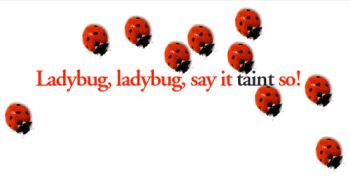That’s Not Very Lady-like
Ladybugs,
now becoming a threat to our wine supply, were commonplace
when I was a small boy in Brooklyn, even in that urban
setting. We naively called them “potato bugs”. I don’t know
why. They congregated on the large leaves of the small trees
we called, with perfect logic, “potato-bug trees”. The bugs
were considered harmless, even vaguely lucky, by the
cognoscenti among us. When abused, the bugs would emit a
pungent-smelling droplet of liquid. The small boys and
smaller bugs, being abstinent, were unconcerned with wine
odors and tastes. But, now grown up, the boys are beginning
to worry.
This same pungent liquid is
increasingly tainting wine. Remarkably small doses can
render a wine impalatable, imparting vegetal (peanut, bell
pepper, asparagus) and earthy and herbaceous smells and
tastes as well as increased sourness and bitterness. Floral
and fruity qualities are damped. Red wine may be slightly
more affected than white. I wonder whether some bottles
called corky might really be ladybugged. Much of the
elucidation of this problem has been done at Brock
University, St. Catharines, Ontario, by a team headed by
Gary Pickering, chair of the Department of Biological
Sciences. The group’s research has been reported since 2OO4
in a series of scientific papers in the journal of enology
and viticulture, journal of food science, international
journal of food science and technology, and
vitis.
The particular species of
ladybug of chief concern, known with more dignity as the
Multicolored Asian Lady Beetle, is Harmonia axyridis. It is
also called Harlequin Lady Beetle, because of color
variation, and Halloween Lady Beetle, because the
promiscuously unladylike rascals, male and female, swarm in
late October just before hibernation. (The males are no
doubt called “girlie bugs” by a certain western governor.)
Ladybugs are more genteelly called “ladybirds” by the
British. The “lady” is short for “Our Lady’s”, a mark of the
esteem in which the critter was held. A related species of
ladybug is the official state insect of Ohio.
Asian Ladybugs, which like
to dine on aphids and scale insects and their eggs (for
breakfast, I suppose), were imported from northeastern Asia
(Japan, Korea, Siberia) by the US Department of Agriculture
on several occasions since the early twentieth century to
control these pests, but with indifferent results. During
the past few years, however, the bugs have proliferated,
perhaps enhanced by the availability of soybean aphids, a
delicacy that migrated from China. Asian ladybugs have
appeared throughout the US and Canada, and now in Europe as
well. Their presence is no longer viewed sanguinely. They
may be attracted to bruised, ripe fruit, especially in
vineyards in the vicinity of soybean fields.
When stressed, as, for
example, when caught in a crusher/stemmer, our ladybugs
respond by reflexly bleeding from their leg joints a
hemolymph (the bugs’ equivalent of blood) that contains
highly potent volatile compounds, especially
2-isopropyl-3-methoxypyrazine (sure looks potent), known
more fondly as IPMP, or ladybug taint. The Multicolored
Asian Lady Beetle’s hemolymph contains IPMP in much higher
concentration than that of other ladybug species. As I
learned long ago in Brooklyn, this is strong stuff. It takes
less than a billionth of a gram per liter of wine for the
taint to be detectible, or the product of one enraged bug
per eleven pounds (five kilograms) of grapes. Individuals
vary in their ability to sense the taint, much like most
odors and tastes. Other than its unpleasantness, the taint
is harmless, to health, that is, but important financial
losses ensue for wine producers.
The presence of ladybugs on
the grapes before the crush does not cause the wine to be
tainted. Any method of bug removal should be gentle.
Methoxypyrazines are normally present in various vegetables
and in some grapes, notably sauvignon blanc and the
cabernets, where just a touch contributes to varietal
character, but excess, as in the unripe fruit of too-cold
vineyards, leads to green, vegetal flavors.
The Pickering group at
Brock has been of late evaluating remedial treatments for
tainted wine. They found that, except for the the
displeasing organoleptics, the chemical structure and
composition of affected wines are otherwise unaltered.
Bottle aging does not help. Tainted wines were treated in a
controlled manner with bentonite, activated charcoal, oak
chips, deodorized oak chips, and ultraviolet light (red
wine) or visible light (white wine). Activated charcoal
reduces the concentration of IPMP in white wine, but not the
sensed taint – puzzling. Oak chips, but not deodorized oak
chips, reduce the intensity of the taint in white and red
wines, especially the asparagus component, without reducing
IPMP. It is thought that oak simply masks the taint.
Deodorized oak appears to enhance asparagus odor in white
wine, without affecting IPMP – also puzzling. Deodorized oak
chips reduce IPMP in red wine. Other treatments have no or
limited effect. Overall, none of the treatments is ready for
prime time.
The search continues,
however, now focused on a protein with high affinity for
methoxypyrazines. It is hoped this protein will bind the
taint-causing compounds, and, used as a fining agent,
eliminate them. Don’t expect satisfaction tomorrow, for
there are obstacles to overcome in getting this scheme to
work.

